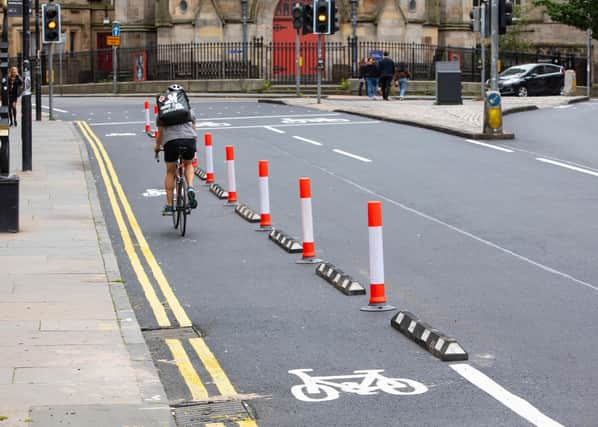Cycling is for life, not just for Covid - Roz Boynton


The Scottish Government and Sustrans initiative was designed to allow temporary infrastructure to give greater room for people to walk, cycle and avoid reliance on public transport. Processions of orange sticks and kerbs in various combinations (known as orcas and narwhals) appeared overnight in towns and cities over Scotland, all with the aim of keeping us moving whilst distanced, away from busy public transport, and preventing the virus taking hold.
Shortly after the pandemic arrived, people in Scotland started taking to cycling in such numbers that finding hens’ teeth would have been easier than a new bicycle. Likewise, the trade in second-hand bicycles has never been healthier. Returning cyclists started pulling dusty bicycles out of the shed and the Cycle Repair Scheme, funded by the Scottish Government, was introduced to get them roadworthy. My normally deserted cycling routes are buzzing with people on bikes. Perhaps this could herald the golden age of cycling in Scotland? We could be the next Amsterdam? With Spaces for People, Scotland could get fit and defeat the virus one pedal stroke at a time.
Advertisement
Hide AdAdvertisement
Hide AdAt Cycle Law Scotland, we have been involved in campaigns for safe cycling since our inception 10 years ago. As a keen cyclist myself, I was somewhat bemused how quickly local authorities were motivated to make changes to roads and paths, where previous demands for such provision had been ignored. Could it have been a sign of governments seeking to do something, anything, to show they had control of an uncontrollable virus? Pushing such cynicism aside, I welcomed Spaces for People. After years of neglect in investment for provision for cyclists,any action being taken must be a good thing for cycle safety. Right?
Wrong! What I have seen as a solicitor representing cyclists involved in accidents suffering injury is that, too often, Spaces for People measures have simply created additional hazards for cyclists. One of my clients suffered a fractured elbow needing surgery when he collided with an unmarked lane divider in a cycle lane corralling him into a limited space with potholes and speed humps to negotiate. A separate client collided with a lane segregator kerb when entering a new cycle lane on Princes Street, Edinburgh at night. The Council’s response was that whilst it was a cycle lane, he wasn’t meant to be entering it there and rather should have merged in with all the traffic first before weaving into the lane. A further client collided with an ‘orca’ speed hump installed only the week before and had since become loose, protruding into the cycle lane. He suffered a fractured collarbone and needs further surgery to repair his shoulder. Whilst good intentioned, it seems the measures implemented under Spaces for People have been poorly thought out, badly implemented and have perhaps endangered, rather than benefited, the burgeoning cycling community.
Indeed, my own observations plus looking at comments on social media and news articles (never a good idea, I know), is that the implementation of Spaces for People has increased animosity between ‘cyclists’ and ‘motorists’. Motorists are angry at the congestion and road closures caused. Cyclists are angry at the poor implementation and motorists not wanting to share the roads. Battle lines are drawn, and attitudes still haven’t changed.
So, as the vaccine is rolled out and we start to hope that normality will be a possibility once again, Councils are announcing the removal and reduction in the Spaces for People. Will the lines of orange sticks on our streets become just one of those weird memories that, in future - like Zoom pub quizzes and sterilising your broccoli - will only make sense if you’ve lived through a pandemic? Or, will there been any lasting change? I’m not convinced but, what I am hopeful of, is that a wave of new cyclists in Scotland will put pressure on councils into thinking about provision for safe cycling as an integral part of transport planning and development, not just as temporary afterthoughts. Cycling is for life, not just for Covid.
Roz Boynton, Associate Solicitor at Cycle Law Scotland